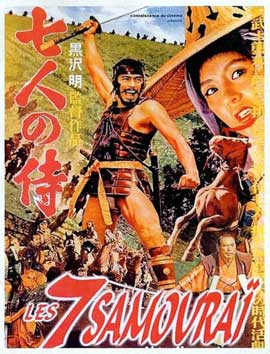
Hi everybody. This is kind of a funny question, but I've seen samurai movies and maybe a few artworks depicting certain soldiers, usually of the lower classes, wearing pieces of armor such as do and sune-ate, but hardly any underlying clothes except for sandals and a loincloth. Toshiro Mifune's character in the Akira Kurosawa film Shichinin no Samurai comes to mind. Is this way of wearing armor a historical fact, or was it just made up for movies? Why might a warrior take off all his clothes for battle? I suppose it might be less hot, and if one were wading through water there would be less clothing to get soaked and heavy, but it still seems pretty odd to me. I've never heard of fighters in Europe doing this, and it kind of suggests that the construction of Japanese armor made it less uncomfortable to wear against the skin; has anyone here tried doing this? What depictions of half-naked men in armor have you seen in art or hisorical sources, and are there other cultures besides Japan where armor was worn this way?
 Attachment: 29.01 KB
Attachment: 29.01 KB


Given the extreme means the Japanese went to in order to save face I find it incomprehensible that a warrior would present himself in battle without being perfectly turned out. The embarrassment to his family would be unforgivable.
Just 'eye-candy' for the ladies.....mostly. ;) The ancient Celts and Greeks are often portrayed going to war wearing very little in way of clothing, much less armor. :eek: .......McM
Keep in mind that for most of history, armour was only worn by the elite. In most armies the vast majority would have a helmet and shield and that is all. The main exceptions were when the state was supplying the equipment such as in Imperial Rome and Byzantium.
Exactly my point, Dan. Thanks! :) ....McM
FWIW, I've seen plenty of ancient and classical Greek depictions of soldiers in armour (and presumably whatever underarmour layer goes with it) but little to no clothing. Might have something to do with climate, comfort... and/or eye candy, indeed - and not just for the ladies, either - whether it's a case of totally ripped people showing off their hot bods for real or period artists taking liberties in the name of hot selling beefcake. :)
:lol: :lol: :lol: .....That's where I was going!.... :lol: :lol: :lol: ......McM
Woah! It seems like my first three commenters are pretty unanimous in thinking this convention is artistic nonsense. I'd really like to hear what Boris Bedrosov or Timo Nieminen might know about this, and if indeed there is any grain of truth to it whatsoever.
In response to Dan's comment about warrior honor, I was never suggesting this was something a respectable member of the bushi would do. Iirc, when you watch those movies like Hidden Fortress it's normally the lowest and poorest of the foot soldiers who are going around in a haramaki-do or hara-ate without clothes, instead of the sumptous armor and clothing you'd expect of a samurai. Also, a lot of these guys in naked armor are far from being either young or sexy, so I doubt the whole convention is for fanservice. The exception might be Kikuchiyo (Mifune): he's wild and disheveled, yet he looks pretty strapping with his clothes off. Keep in mind, however, that despite the title "Seven Samurai", Kikuchiyo actually turns out to be a peasant using a fraudulent samurai geneaology, so he has no illustrious ancestors to offend.
In response to Dan's comment about warrior honor, I was never suggesting this was something a respectable member of the bushi would do. Iirc, when you watch those movies like Hidden Fortress it's normally the lowest and poorest of the foot soldiers who are going around in a haramaki-do or hara-ate without clothes, instead of the sumptous armor and clothing you'd expect of a samurai. Also, a lot of these guys in naked armor are far from being either young or sexy, so I doubt the whole convention is for fanservice. The exception might be Kikuchiyo (Mifune): he's wild and disheveled, yet he looks pretty strapping with his clothes off. Keep in mind, however, that despite the title "Seven Samurai", Kikuchiyo actually turns out to be a peasant using a fraudulent samurai geneaology, so he has no illustrious ancestors to offend.
Last edited by Michael Parker on Thu 14 Dec, 2017 11:14 pm; edited 1 time in total
If he was trying to conceal the fact that he wasn't a samurai, he wouldn't be flagrantly displaying his ignorance. One would think that he would take more care than anyone else over his appearance.
| Michael Parker wrote: |
| Hi everybody. This is kind of a funny question, but I've seen samurai movies and maybe a few artworks depicting certain soldiers, usually of the lower classes, wearing pieces of armor such as do and sune-ate, but hardly any underlying clothes except for sandals and a loincloth. |
Ashigaru (Japanese light infantry, non-samurai) usually wore tight pants and a shirt, whether or not they wore armour. Often, knee-to-ankle leggings on top of their pants. Some art shows ashigaru with short pants, stopping just above the knee, and then knee-to-ankle leggings.
The closest to half-naked I've seen has been some soldiers wearing armour, without visible pants:
[ Linked Image ]
They're wearing shirts under their armour. Note that most of the soldiers here are wearing short pants and leggings; bare legs are a minority.
Some pants of the type worn by ashigaru:
[ Linked Image ]
https://www.pinterest.com/pin/7881368068646407/
These pants are called momohiki, and are common work-pants for farmers and labourers, worn by both men and women.
The leggings are called kyahan: https://en.wikipedia.org/wiki/Kyahan
Bare legs is often a sign of dysentery. After a couple of days of constantly dropping their pants to crap, many gave up and started walking around butt naked. After a couple more days many stopped bothering to go to the latrine and simply let it run down their legs.
| Dan Howard wrote: |
| If he was trying to conceal the fact that he wasn't a samurai, he wouldn't be flagrantly displaying his ignorance. One would think that he would take more care than anyone else over his appearance. |
To be fair, at the point when Kikuchiyo acquires this outfit he's a peasant half-assedly pretending to be a samurai temporarily pretending to be a bandit (and not fooling anybody for long with either pretense). He's a complicated character. :D
| Dan Howard wrote: |
| Bare legs is often a sign of dysentery. After a couple of days of constantly dropping their pants to crap, many gave up and started walking around butt naked. After a couple more days many stopped bothering to go to the latrine and simply let it run down their legs. |
And while soiling yourself on the march may seem crazy, when you gotta go you gotta go - in both senses of the word. The formation won't stop and wait just because you have the runs.
War is hell.
Dysentery? Mother 'o mercy! Gives me the shudders just thinking about having the runs so bad that one would give up on wearing pants.
Tiemo, I found a lot of evidence for what you said about short pants and kyahan leggings being popular. You started us off with a detail from that Night Attack on the Sanj˘ Palace scene, illustrated in the second half of the 13th century. I found another good picture of short pants and kyahan in the 14th century hanging scroll, Illustrated Biography of Prince Shotoku, and in a Scene from the Rokuhara Imperial Visit - Chapter of The Tale of The Heiji, both at the Met.
It seems that bare shoulders are more difficult to find than bare knees. However, I did find a picture of Japanese pirates from I know not what source, and while I may be mistaken because of the low resolution, I think there may be some guys wearing the cuirass with naked shoulders. There are also two scrolls shared between Japan and China from around the 17th century depicting the Wako clashing with Chinese forces, in which the wako are often shown butt naked except for shirts or jackets. Maybe that's how the idea got to this Osprey-looking modern picture of fierce and disheveled Wako; not sure how much of that's plausible and how much is artistic license.
I also found, on wikimedia commons, a depiction of guys in cuirass with unclothed arms and shoulders as well as bare knees, but whoever posted it doesn't know what book it was published in. They said it might date from the 1800s. Actually, it seems like there's bare-footedness in a lot of these pictures, unless it was just an artistic convention not to draw visible sandals or something. Was fighting while barefoot ever effective?
 Attachment: 338.75 KB
Attachment: 338.75 KB
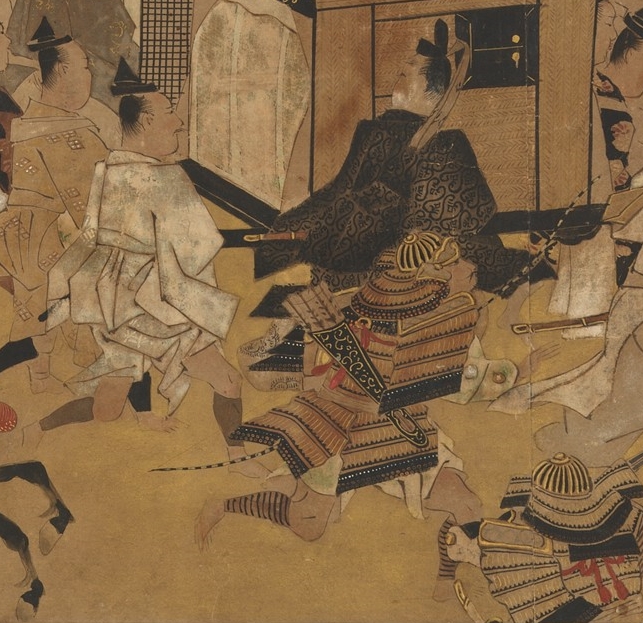
Scene from the Rokuhara Imperial Visit - Chapter of The Tale of The Heiji
 Attachment: 430.58 KB
Attachment: 430.58 KB
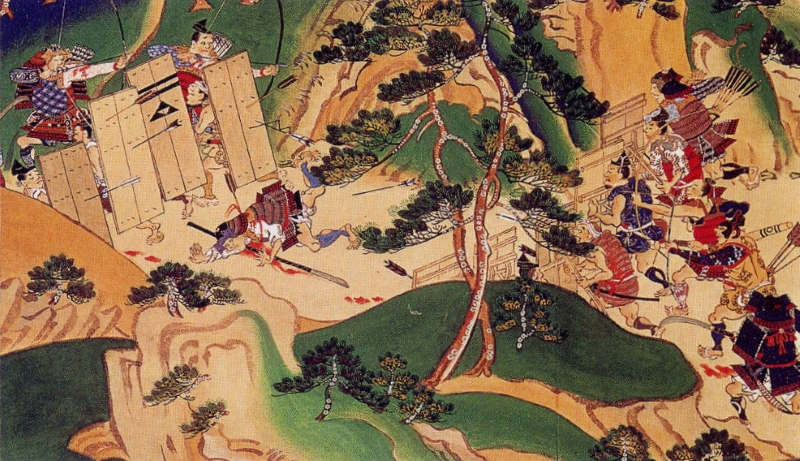
Samurai_using_shields_(tate)
 Attachment: 325.49 KB
Attachment: 325.49 KB
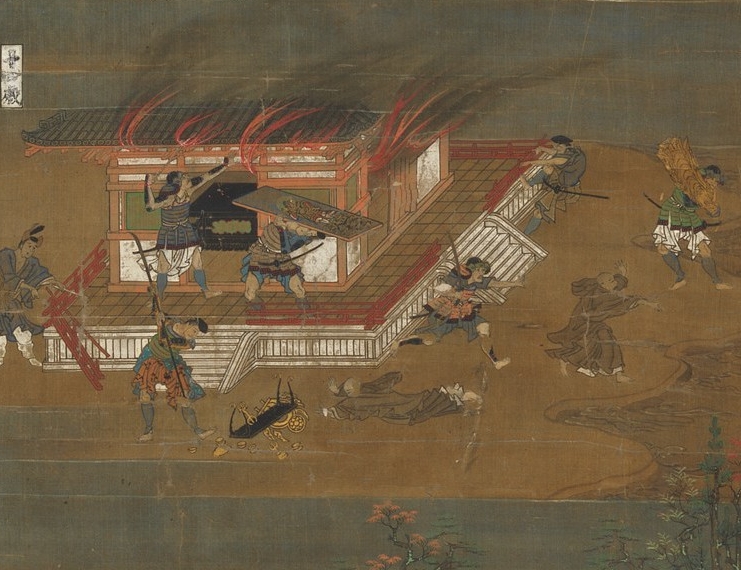
Illustrated Biography of Prince Shotoku 14 c
 Attachment: 322.33 KB
Attachment: 322.33 KB
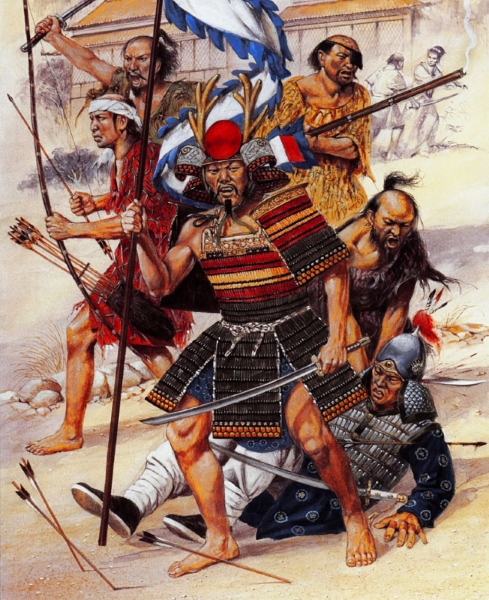
Wako Pirates Modern Artist's Impression
 Attachment: 352.44 KB
Attachment: 352.44 KB

Wako Scroll 17 c
 Attachment: 290.58 KB
Attachment: 290.58 KB
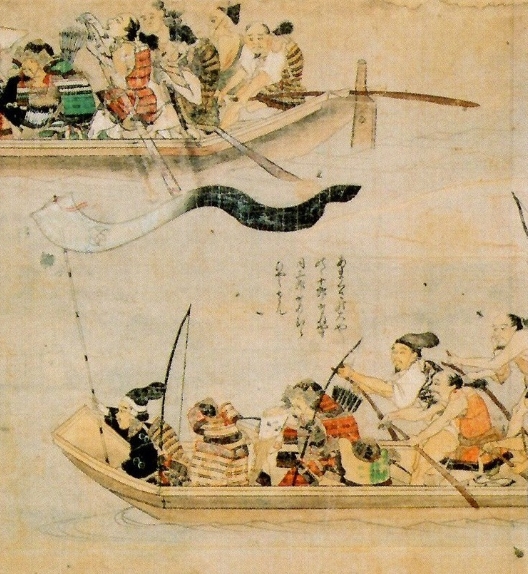
Do I see some bare shoulders? Hard to tell.
Tiemo, I found a lot of evidence for what you said about short pants and kyahan leggings being popular. You started us off with a detail from that Night Attack on the Sanj˘ Palace scene, illustrated in the second half of the 13th century. I found another good picture of short pants and kyahan in the 14th century hanging scroll, Illustrated Biography of Prince Shotoku, and in a Scene from the Rokuhara Imperial Visit - Chapter of The Tale of The Heiji, both at the Met.
It seems that bare shoulders are more difficult to find than bare knees. However, I did find a picture of Japanese pirates from I know not what source, and while I may be mistaken because of the low resolution, I think there may be some guys wearing the cuirass with naked shoulders. There are also two scrolls shared between Japan and China from around the 17th century depicting the Wako clashing with Chinese forces, in which the wako are often shown butt naked except for shirts or jackets. Maybe that's how the idea got to this Osprey-looking modern picture of fierce and disheveled Wako; not sure how much of that's plausible and how much is artistic license.
I also found, on wikimedia commons, a depiction of guys in cuirass with unclothed arms and shoulders as well as bare knees, but whoever posted it doesn't know what book it was published in. They said it might date from the 1800s. Actually, it seems like there's bare-footedness in a lot of these pictures, unless it was just an artistic convention not to draw visible sandals or something. Was fighting while barefoot ever effective?

Scene from the Rokuhara Imperial Visit - Chapter of The Tale of The Heiji

Samurai_using_shields_(tate)

Illustrated Biography of Prince Shotoku 14 c

Wako Pirates Modern Artist's Impression

Wako Scroll 17 c

Do I see some bare shoulders? Hard to tell.
Well, it's not an easy topic. As far as high ranking samurai, from the early ages to the late 14th century, the kind of arming garments they used was the daily outfit of the nobles, the so called Yoroi Hitatare. That usually covers completely the torso and it was common to see leggins + short trousers. For the lower class soldiers, it was even more common to see short trousers and that's is probably influenced by the fact that Japan during summer is extremely hot and humid.
Later on the 15th and 16th century, the upper class warriors started to use less fancy outfits and rely more on low class daily outfit, since they were comfortable. The standard kimono is often referred as Shitagarami and there were also more layers of clothes like Manchira arming jacket. Padding types of clothes were also worn during the winter, especially in the north regions.
However the south was extremely hot during summer; in fact reading Louis de Frois account in the 1580s, he describes the warriors in Kyushuu wearing little to no clothes before wearing armor.
On the other hand there are a depictions of warriors completely cover in armor and clothes.
So it was done mainly in summer and probably on the southern part of the Island. It might be weird to see but ventilation and overheating are extremely important factors.
Also, as far as the Wokou are concerned, they didn't wear pants or trousers because while being on boat the chances to have wet and heavy clothes all the time was higher than on land.
I also think that this kind of behavior was also common in south east Asia like in the modern day Philippines.
Later on the 15th and 16th century, the upper class warriors started to use less fancy outfits and rely more on low class daily outfit, since they were comfortable. The standard kimono is often referred as Shitagarami and there were also more layers of clothes like Manchira arming jacket. Padding types of clothes were also worn during the winter, especially in the north regions.
However the south was extremely hot during summer; in fact reading Louis de Frois account in the 1580s, he describes the warriors in Kyushuu wearing little to no clothes before wearing armor.
On the other hand there are a depictions of warriors completely cover in armor and clothes.
So it was done mainly in summer and probably on the southern part of the Island. It might be weird to see but ventilation and overheating are extremely important factors.
Also, as far as the Wokou are concerned, they didn't wear pants or trousers because while being on boat the chances to have wet and heavy clothes all the time was higher than on land.
I also think that this kind of behavior was also common in south east Asia like in the modern day Philippines.
Climate and temperature only matter for helmets. So long as the head is ventilated there is no problem wearing any kind of armour. I've done it all day in Australian summers in the outback and in the tropics. No soldier ever changed the type of armour he wore because of the climate. Leather and cloth armour are even heavier than metal armour and just as stifling, if not more so. We know that some of the heaviest and most stifling armours ever invented were worn in summer campaigns in arid regions of the Middle East for centuries. The problem is that Europeans and many northern Americans are not acclimated to these conditions - especially today when every building has air-conditioning. They have difficulty operating in this kind of climate even when they are wearing no armour at all.
I don't think that Luca anyone else suggested that Japanese fighters would have worn fewer pieces of armor in response to the heat or humidity; so far we're just talking about whether they might have ever chosen to wear less than the maximum amount of clothing or padding underneath it.
| Michael Parker wrote: |
| Was fighting while barefoot ever effective? |
I'm not so sure about other places, but native troops in the Netherlands East Indies (now Indonesia) regularly went barefooted into the early 20th century. Generally speaking, the rule was that the majority of native enlisted men were barefoot while enlisted Europeans wore shoes. Officers -- both European and native -- wore boots. This was a pretty important distinction because the privilege of wearing shoes and sleeping in bunks/cots (rather than mats laid to the floor) was used to distinguish certain groups from the bulk of native enlisted personnel. For instance, the "Belanda Hitam" ("Black Dutch") troops were recruited from Africa with the enticement of being treated as equal to Europeans from a military standpoint, and they mutinied at one point when they were barracked in a place where they had to sleep on mats/mattresses on the floor (like native troops) rather than beds (like Europeans). Similarly, Ambonese Christian troops were given part of these privileges to elevate them to a halfway point between most native troops and the Europeans in a calculated divide-and-rule policy to make them see themselves apart from the natives and be more loyal to the Dutch.
I'm pretty sure there are images of Abyssinian troops fighting barefooted (and these were serious, militarily skilled regulars, not lower-tier militias) in World War II. Many African tribal conflicts today -- whether fought with firearms or with bows and arrows (such as the recent Kalenjin-Kisii clashes in Kenya) are fought by men in bare feet or flip-flops. I've also met some regular Indonesian soldiers just a few years ago who left their boots back at base and preferred to wear flip-flops in border enforcement patrols through areas where they might have to wade into water up to thigh deep.
On the subject of fighting barefoot: Native Irish kern and gallowglass were often noted as fighting barefoot by the English, if memory serves.
| Joshua R wrote: |
| On the subject of fighting barefoot: Native Irish kern and gallowglass were often noted as fighting barefoot by the English, if memory serves. |
It might have been a cost issue rather than a personal preference. How many would have worn shoes if they could afford them?
With the Japanese, it was (still is) customary to remove shoes when indoors. If there was an attack and you had to rush outside, you wouldn't stop to put on shoes.
Page 1 of 1
You cannot post new topics in this forumYou cannot reply to topics in this forum
You cannot edit your posts in this forum
You cannot delete your posts in this forum
You cannot vote in polls in this forum
You cannot attach files in this forum
You can download files in this forum
All contents © Copyright 2003-2006 myArmoury.com — All rights reserved
Discussion forums powered by phpBB © The phpBB Group
Switch to the Full-featured Version of the forum
Discussion forums powered by phpBB © The phpBB Group
Switch to the Full-featured Version of the forum